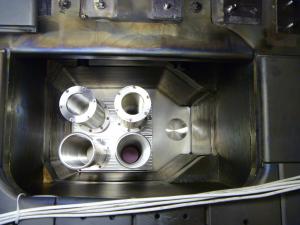Novel, cost-saving design for key diagnostic tool
Scientists working under the leadership of Princeton Plasma Physics Laboratory (PPPL) have developed and are preparing to test a new design for a key diagnostic instrument for ITER. If proven successful, the design could replace the more conventional, bulkier instrument now planned.
The new diagnostic design marks a nationwide effort by researchers in support of US contributions to ITER. Scientists at the University of California at Los Angeles and Oak Ridge National Laboratory developed the prototype instrument, which is being tested on the DIII-D Tokamak in San Diego. "This is a good example of US fusion experts working together to support the conceptual design," said PPPL physicist Dave Johnson, who heads the development of the diagnostic tools for US ITER.
The prototype instrument, called a reflectometer, measures the electron density profile of the plasma gas that fuels fusion reactions. The profile shows changes in density from the volatile edge of the plasma to the centre of the plasma core, and must be maintained at an optimal level for a stable self-sustaining reaction, or burning plasma, to take place.
The prototype represents a sharp departure from standard "bistatic" reflectometers that use dual antenna systems—one to launch radar-like microwaves towards the plasma through waveguides, and a second one to carry back the reflected signal for analysis. By contrast, the new design features a single, or "monostatic," antenna/waveguide system to both deliver and return the microwave signal from the plasma.
"The goal of the DIII-D test is to see whether you can launch and receive the reflected power on the same antenna," said Tony Peebles, head of the UCLA Plasma Diagnostics Group that designed the monostatic system together with ORNL engineer Greg Hanson, who created the waveguides that carry the microwave signal.
The single antenna/waveguide system will capitalize on the vast size of ITER, where the vacuum window for the ITER antenna will be many metres from the plasma. This extended propagation distance "will make it significantly easier to filter out spurious radar images," said Peebles. If the tests on DIII-D are successful, he noted, the prospects for a monostatic system look promising for ITER.
Benefits of the monostatic system could range from increased diagnostic capability to potential cost savings. Six monostatic transmission systems could perform the same measurements as the twelve bistatic systems currently planned for ITER. This "monostatic advantage" would allow a potential cost-savings related to construction, installation and maintenance.
Researchers at DIII-D will be led by UCLA in testing the monostatic prototype on the tokamak starting in May and running throughout the summer. "We hope to learn enough from the DIII-D tests to assess the feasibility of the monostatic design," said Johnson. "Based on these results we will possibly make a recommendation to modify the reflectometer to be monostatic."
Read more on the PPPL website.


